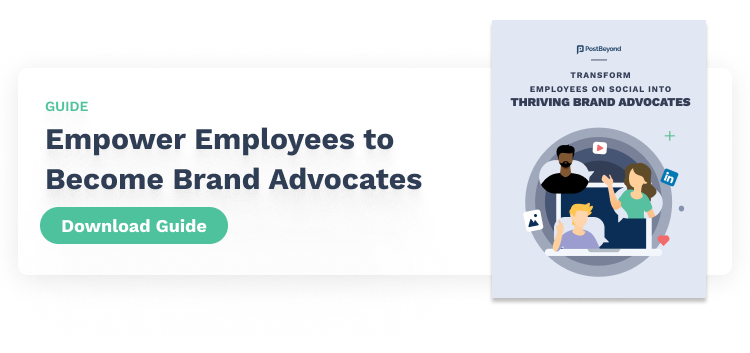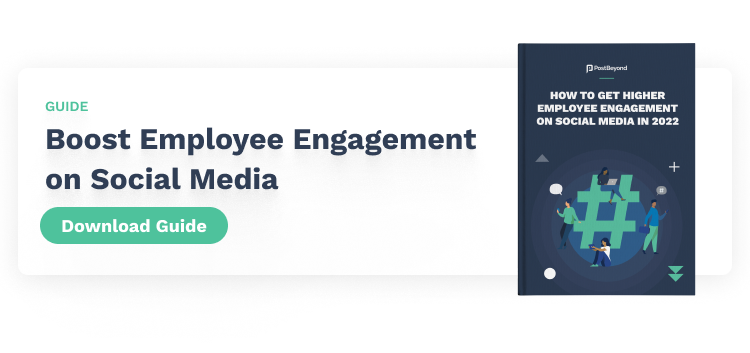Note: We updated this blog on the importance of using social media in marketing with fresh insights to set you up for success in 2023.
As 2022 closed and opened to 2023, many markets entered into a recession. This has put a squeeze on marketing budgets, affecting headcount, marketing programs, and martech tools. But astute marketing managers and leaders can see why social media marketing is important, now more than ever.
This is a tough economy, and chances are that it’ll be harder to get new customers and, just as importantly, keep your existing customers. It’s not just about fresh leads, but keeping revenue up across every front. The use of social media marketing will be critical for engaging existing customers, reaching new audiences, building trust and loyalty (that carries into renewals, upsell and cross-sell growth, etc), and much more.
Why?
Because – today more than ever – buyers listen to real people, not brands. They trust the real- world experiences of their peers, not slick marketing copy. They value authenticity, not ads.
Here’s a recent example of that exact sentiment on LinkedIn.
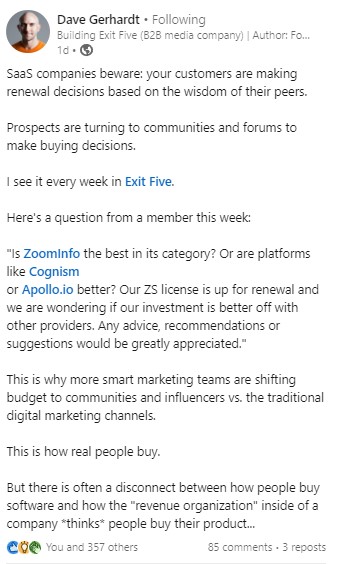
Basically, social media platforms (especially LinkedIn) are communities of real people. In fact, one can say that every individual LinkedIn post is a community in itself. People congregate to those posts to share ideas, give advice, answer questions, provide support, and much more.
Notice something? Brands aren’t starting those conversations, nor are they driving them. It’s all people. So, when thinking about a social media marketing strategy, you absolutely need to pair it with a brand advocacy program centered on your employees and customers.
However, both strategies center on marketing using social media.
Why is Social Media Marketing Important? Builds Communities
The reason why social media marketing is important now more than ever is because social media is where buyers and customers are engaging.
Basically, people are reaching out to one another for guidance, advice, information, resources, and much more. Those people who provide all that begin standing out as thought leaders and subject matter experts. Their perspectives sway decisions.
As a marketing leader, you want to have people associated with your brand (i.e., employee advocates and customer advocates) to lead those conversations. Your goal is to get brand advocates to build and guide these social media communities.
Why Is Social Media Important for Your Business? 12 Reasons.
Even though B2B companies seek to sell products to other businesses, B2B marketing is still built on human relationships. Social media has long been used to help grow these relationships, but its importance accelerated last year.
Without in-person events, B2B marketers needed an outlet to connect with prospects and partners. And they found they could do this most effectively via social platforms.
By using social media, B2B leaders:
1. Build Brand Awareness
Across different platforms, companies can tell their story, why they provide the services they offer, and keep audiences updated with customer and employee stories.
If B2B leaders are able to leverage the voice of their employees, they can extend their brand reach even further. Every employee has a personal network, and each network has potentially hundreds of contacts. In turn, each of those contacts is connected to hundreds of other people. When your employees are in deep sync with their networks, they can achieve a lot, not just on social, but in real life too (e.g., create flyers, send direct mail, network at events, etc).
2. Generate Leads
Create meaningful conversations and engagement within their target industry by posting videos, news, data, and interesting trends. Not only do you build credibility with potential customers, but these strategies can result in gaining leads.
3. Nurture Leads
Social selling enables sales professionals to build relationships with leads. By leveraging their thought leadership pieces, social proofing and other content, they can help potential customers solve problems. In turn, this allows your sales team to build trust and credibility.
4. Implement Social Listening
Listen to customers and what people are saying about their company. This gives you a chance to get candid feedback about how others view your brand. It opens a window into improving the weaker areas of your business while reinforcing aspects that already resonate with people.
5. Connect Social Posts to Opportunities

With the right enterprise solution, leaders can drive customer posts to their CRM to understand customers more fully.*
6. Measure Marketing Efforts
Social media platforms and management tools enable you to track key performance metrics (KPIs). You can even assign a monetary value to organic social media engagement. Earned media value (EMV) offers an idea of how much organic social engagement and reach would have cost if you paid in ads.
7. Build Brand Authenticity
Engaging on social media gives brands the opportunity to build trust with potential customers, partners and talent/employees. This is especially true if other people are promoting your brand or products/services to other people. People are almost three times as likely to trust advice or recommendations from family and friends than official brand channels.
8. Drive Thought Leadership
Social media is a great way to learn about the problems and interests of people. In turn, being on social gives brands an opportunity to drive thought leadership by solving problems. Create how-to guides, webinars and other content to help people and, in response, people could trust your brand as their source for guidance.
9. Grow Your Audience

In 2021, 4.48 billion people were using social media. Not only does social give you a window into the largest addressable market online, but it shows you what actual people talk about or like. Once you learn how to solve this market’s problems with thought leadership content, you can build an audience that believes in your brand and products and services.
10. Build a Community
With planning and engagement, you can build an active community around your brand on social. You can leverage employees and customers alike to generate immediate Likes and Shares for your content so that it reaches new audiences.
11. Generate Unique Content at Scale
Social media communities can also be an excellent source of original and thoughtful content. User-generated content (UGC) and employee-generated content (EGC) can speak to brands in authentic ways, but they keep your content publishing pipeline flush with lots of fresh options.
12. Stay Top of Mind With Key People

Spreading thought leadership through social media is a go-to method of meriting the attention of decision-makers and other top stakeholders. Leverage webinars, ebooks, one-pagers, podcasts and other content types to solve problems for other people.
If you want to connect and engage with your future customers, you have to be where they are. And that’s largely on social media.
13 Stats Showing Why Social Media Marketing Is Important
Marketing on social media platforms helps you showcase employee stories, your brand’s vision and values, and create an emotional connection with audiences (yes, B2B companies should strike the emotional chord just like B2C companies do).
The data helps us gauge social media marketing effectiveness:
- 89% of marketers say social media is “Very important”, with 30 percent saying it’s “Somewhat important” to their overall marketing strategy, according to Buffer.
- Youtube accrues more than 1 billion hours of watch time each day.
- 82% of B2B marketers report using LinkedIn as a means of networking and making professional connections. They also use Facebook, Twitter, Instagram, Youtube, and Pinterest.
- In 2017, 80% of social media B2B leads came from LinkedIn. (LinkedIn)
- 53% of the world’s population is now active on social media. (We Are Social)
- 13 new users are starting to use social media for the first time every second (Hootsuite).
- 70% of adults said they trusted recommendations online from friends and family, but only 15% said they would trust a companies’ official social media posts (PostBeyond).
- 91% of B2B buyers actively use social media (IDC).
- 79% of job applicants use social media to search for employment openings. However, 86% of applicants use social media for their job search in the first 10 years of their career (Glassdoor).
- 93% of Twitter members say they’re open to letting brands join a conversation, especially when they provide help (Twitter).
- 90% of Instagram members follow a business or official brand account (Instagram).
- LinkedIn says it has almost 800 million members across 200 countries. North America makes up around 25% of that population.
- Facebook reaches 59% of the global social media population. It’s the only social media platform that’s in the hands of over half of the world’s social media users.
Amid the pandemic, social media became even more important for B2B marketers. In a 2020 LinkedIn survey of 1,200 marketers, three out of four of those in B2B experienced budget cuts, forcing them to put more focus on tactical elements of marketing and short-term investments that clearly pay off.
“Having fewer resources and levers forces you to think differently, and our focus has been on providing value to our customers,” responded in the survey, Simon Morris Senior Director Digital Media Marketing at Adobe EMEA. “We’ve done a lot more to digitally network with them.”
Networking digitally allows teams to connect in new ways, spread company news through word-of-mouth online, and broadcast virtual events.
Why Employee Advocacy is a Great Use of Social Media for Marketing
One way companies can think differently about their social media strategy is by developing an employee advocacy program.
Employee advocacy is the promotion of a company by the people who work for it. When employees are proud to be working for a company, they’ll want to let the world know. And when they do so, their voices go further and gain more trust than traditional branding.
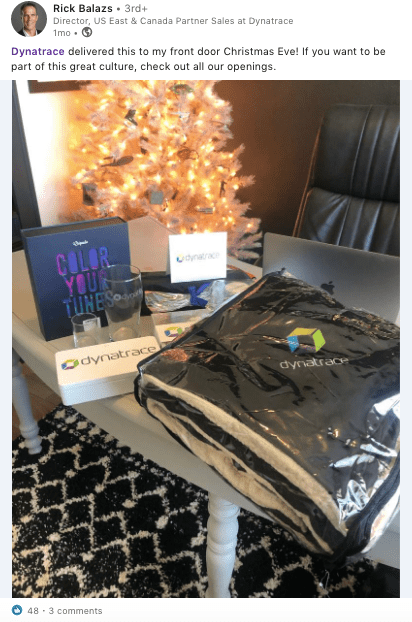
Study after study shows that word-of mouth marketing is effective. When employees share their experiences, their social connections are more likely to see their content, leave a comment, and trust the post more.
A study from Fleishman Hillard even found that consumers trust a company’s employees three times more than the company leaders.
Employees should be encouraged to share original posts that promote the company in order to boost organic reach, build brand credibility, and attract better-qualified leads.
Strategy on How to Use Social Media Marketing Effectively
When it comes to using social media in marketing, you need to make sure you’re hitting these five key points:
1. Create a social media strategy by answering key questions
Before publishing posts, develop a social media strategy that executives, the legal team, marketing, and sales will all agree on. Identify why social is being used as a marketing and sales channel, and if there will be any roadblocks. For example, regulated industries like financial and healthcare must follow strict rules.
As part of the overall social media strategy, a policy should be put in place for all stakeholders on what to share and what is off-limits.
After laying the ground rules, consider the following questions when developing a strategy:
- What are your goals and how will you measure them?
- What type of content will you post?
- When will you post?
- What channels will you prioritize?
- Who will create and distribute content?
- How will you encourage employees to share content?
2. Choose a social media management tool
There are several social media management tools that help social media managers plan and distribute their content. Top tools include Buffer, HubSpot, Zoho Social, Falcon.io and Hootsuite. Many of these tools are designed to help companies reach audiences on Facebook, Instagram, and Twitter. To reach target audiences on LinkedIn, LinkedIn Sales Navigator is a premium tool for information on leads and it gives you the ability to send InMail messages to target accounts.
3. Train employees
Once you have a policy developed and tools set in place, it’s time to train employees. Whether they must attend a training webinar or read an employee social media handbook, it’s important employees know what the expectations are. Be sure to include the regulations, but also train employees on what drives engagement with future customers.
Not everybody will be a natural social media pro at first, but most people can get the hang of it when they understand its importance and how their contribution helps drive revenue.
4. Identify and collaborate with industry influencers.
Influencers aren’t just for B2C. Identify employees who are savvy on social media, and who would be a good fit to partner with your industry’s influencers by interviewing them on a live stream, webinar, or podcast.
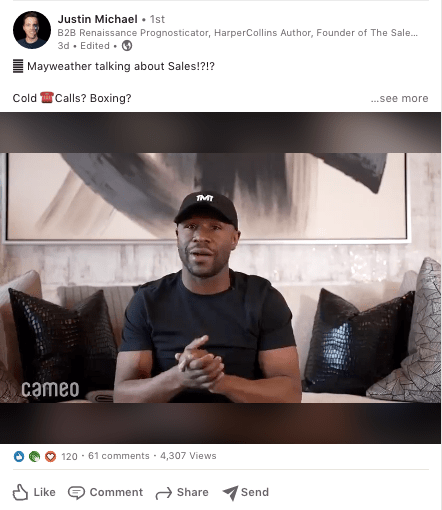
No matter how you choose to partner with an influencer, the content can be later reused for social media posts.
5. Create a content calendar and approval process
One key to successful social media marketing is organization and attention to detail. In order to publish engaging content, social media teams need to establish a content calendar and approval process.
With an editorial calendar, marketers can schedule out content on a weekly, monthly and quarterly basis. Beyond publish dates, editorial calendars help content teams track content type, purpose, authors, channels and more.
When creating this calendar, don’t forget to track the most successful posts in order to republish your most popular content.
Looking Forward to Social Media in 2022
It’s never too late to start maturing your social media strategy. Whether that means starting from scratch or encouraging employees to build their personal brands, the importance of social media has never been greater.
Learn how to identify your most influential employee advocates by reading our latest guide.

